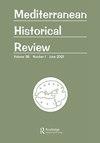Sea change: Ottoman textiles between the Mediterranean and the Indian Ocean
IF 0.2
2区 历史学
Q1 HISTORY
引用次数: 0
Abstract
ful additions, including a chronology, a genealogical chart of the Abbasid caliphs, a glossary, three maps, and thirty-two images. The chronology and glossary are extremely useful for those planning to use this book in the classroom. These are wonderful reference tools for anyone approaching Abbasid history for the first time, which will help students find their bearings. The images, twenty-three black and white and nine in full color, appear as plates in the center of the book and include a mixture of coins, architecture and archaeology, details of architectural decoration, and manuscript pages and illuminations. Unfortunately, many of these images are very small and surrounded by a great deal of blank space, suggesting that they could have been enlarged without adding additional pages to the book. Three maps are situated at the front of the book, including one map showing the overall extent of the Abbasid caliphate at its height, along with its 9th-century neighbors, the provinces of Iraq and Iran (taken from Guy LeStrange), and a focused map of Baghdad (taken from Richard Coke). Considering the purposes of the book, it is unfortunate that the maps capture the Abbasid caliphate only in its golden age rather than presenting an evolution of the caliphate into the 10th, 11th, 12th, and 13th centuries. Chapters 4, 5, and 6 would benefit greatly from specialized maps that illustrate the changing nature of the caliphate and the growth of its rivals and successors, especially considering the excellent pedagogical applications possible for the book. Of course, it should be noted that it is not clear if these were choices made by the author or the publisher.海洋变化:地中海和印度洋之间的奥斯曼纺织品
本文章由计算机程序翻译,如有差异,请以英文原文为准。
求助全文
约1分钟内获得全文
求助全文

 求助内容:
求助内容: 应助结果提醒方式:
应助结果提醒方式:


